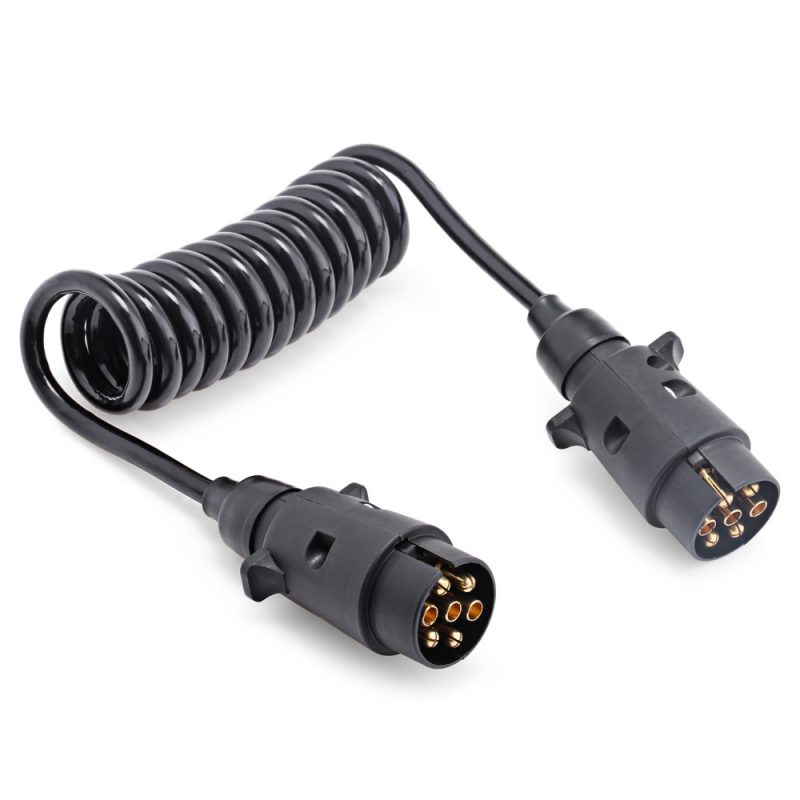

Physical design according to standard ISO 12098. The combination of 12N+12S was replaced in 2008 by the 13-pin ISO 11446 connector.įeed for internal 12V equipment except refrigeratorĢ4 Volt 15-pin trailer connector ISO 12098 (Towing vehicle side) This means that if a pre-1999 camper trailer with a battery is connected to a post 1999 vehicle there's a risk that the battery charging won't work. The difference is that an additional connection for ground and that battery charging in the trailer is shared with other consumers.

There are two main variants of the wiring with a switchover date 1999. This is used in Great Britain but may also be used in other areas of Europe. The purpose of this connector is to supplement the 12N (ISO 1724) connector for power supply of consumers common in caravans (Travel trailers). Socket is replaced with pin in the plug, pin is replaced with socket in outlet. This connector is basically the same as the 12N (ISO 1724) connector, but the center pin (pin 7) has changed gender to make the plug and outlet unique. Signals in this connector (if following the standard) are not generally legally required (local regulations may still apply), which means that it is not mandatory to connect it if it is present. Physical design according to standard ISO 3732. įurther reading at Trailer Connector/Australia.ħ-pin trailer connector Type 12S (ISO 3732) ħ-pin ISO 3732 trailer connector type 12S (Towing vehicle side) The problematic part here is that pin 5 is used for trailer brake which means that if you for some reason connect an Australian trailer to a towing vehicle with ISO wiring you will get into trouble with the trailer brakes being applied as soon as you turn on the lights. (Vehicle wired for +12V, permanent or via ignition and trailer wired for fog lamps)Īustralia uses basically the same wiring with the exception for pin 5 and pin 2. This is why in regions using this connector, trailers on the road are occasionally seen with the rear fog lights on when they should be off. Later pin 2 (54G) has been used for a variety of functions different from the original intent. #Īccording to DIN 72552 pin 54G was initially intended for electrical control of brakes on trailers. Joining the pins for right and left tail lights (58R and 58L) can cause problems on German cars where it is possible to activate Standing Lamps on only one side of the vehicle.

In these cases exclude connection for right tail light (58R) and rear fog light (54G) and connect the tail lights only to pin for left tail light (58L). On older trailers there's sometimes a 5-wire setup using a 7-pin connector. The 7-pin connector uses on newer trailers all 7 pins according to the ISO standard. Physical design according to standard ISO 1724. The following supplementary information exists for the connector:ħ-pin ISO 1724 trailer connector type 12N (Towing vehicle side) Reversing lamps, control current to block surge brakes when reversing.
7 PIN TRAILER CONNECTOR REGISTRATION
Tail lamps, clearance lamps/outline marker lamps and registration plate lamp left side Tail lamps, clearance lamps/outline marker lamps and registration plate lamp right side Physical design of the standard ISO 11446 but also called Jaeger-connector from the company that developed it. The color coding is defined in ISO 4141-3, but the standard color codes are not always followed and may be different for a particular vehicle.ġ3-pin trailer connector ( ISO 11446) Heavy trucks that may have 12V systems are usually older (vintage vehicles) or on non-European markets. Vehicles and trailers with 6V systems can use the 7-pin or a 5-pin connector, but these are rare today. Exceptions for the 7-pin connector may exist where they may be used for 6V and 24V. The connectors are designed for 12V systems. The 13-pin version being phased in is newer, provides more services than the 7-pin, a more positive locking and also better protection against moisture and contamination. In Europe, both 7-pin (ISO 1724) and 13-pin (ISO 11446) are common. Trailer connectors between the trailer and passenger car, light truck or heavy trucks with 12V systems

2.4 7-pin trailer connector 24S (ISO 3731).2.3 7-pin trailer connector 24N (ISO 1185).2.2 7-pin trailer connector for ABS/EBS (ISO 7638-1).2 Trailer connectors between heavy duty trailer and the tractor unit.1.4 7-pin trailer connector Type 12S (ISO 3732).1.3 7-pin trailer connector Type 12N (ISO 1724).1.2 7-pin trailer connector for ABS/EBS (ISO 7638-2).1 Trailer connectors between the trailer and passenger car, light truck or heavy trucks with 12V systems.


 0 kommentar(er)
0 kommentar(er)
